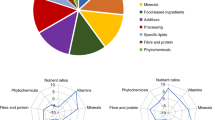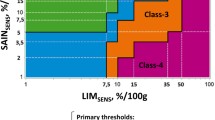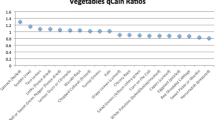Abstract
Nutrient profiling is a discipline aimed at classifying foods based on their nutritional composition. So far, several profiling schemes have been proposed for varied purposes world-wide. Primary aim to inventory the main profiling schemes that have been developed so far (both applied and not) and to summarise their main aspects. Secondary aim to critically review a selection of them, to test their “performance” and to evaluate their strengths and weaknesses. Scientific and popular search engines were used for identifying profiling schemes. Schemes were described concisely by providing details on four main “Building Blocks” or factors: (1) Food category declination: category-wise or “across the board”; (2) Reference amount: 100 g, 100 kcal; serving; (3) Cut-off use: thresholds or scores; (4) Nutrients Selection: balance between positive and negative nutrients and number of them. The “performance” analysis was done by testing how the selected schemes classify a sample of food. Profiling schemes display considerable variation based on the underlying approach, format and content. Moreover, the rationale of the schemes largely varies and seems to be inspired by either nutrient recommendations or regulations figures. When tested for “performance”, the five selected schemes classify in the same way foods having either a very “positive” or a very “negative” nutrient profile, whereas they give inconsistent results for food products with intermediate characteristics. Strengths and weaknesses analysis shows the difficulty of finding schemes combining qualities such as simplicity, scientific relevance, ability to cope with changes in nutrient recommendations. Current proposed profiling schemes exhibit a wide range of differences both in terms of approaches and “performance”. Nutrition scientists have now the challenge to develop the “ideal scheme” that, in our view, will have to be strict enough to ensure consumer protection but also flexible enough to encourage food industry innovation and to promote a “healthy” competitive market.
Similar content being viewed by others
References
ANFZA (2003) A pilot for health claim system, 2003. Internet website ANFZA. Australia New Zealand Food Authority, AUS
Black A, Rayner M (1992) Just read the label: understanding nutrition information in numeric, verbal and graphical formats. The Coronary Prevention Group, London, HMSO
British Heart Foundation (BHF) (2005) Guide to food labelling. BHF, London (bhf.org.uk)
COMA (1991) Department of health, dietary reference values for food energy and nutrients for the United Kingdom. Report on Health and Social Subjects No. 41. HMSO, London
COMA (1994) Department of health, nutritional aspects of cardiovascular disease. Report on Health and Social Subjects No. 46. HMSO, London
Code of Federal Regulation, title 21: food and drugs, vol 2, revised as of April 1, 2003; Chapter 1: Food and Drug Administration, Department of Health and Human Services, Part 101: food labelling; Sec. 101.14 Health claims: general requirements. U.S. Government Printing Office
Corrigendum to Regulation (EC) No 1924/2006 of the European Parliament and of the Council of 20 December 2006 on nutrition and health claims made on foods. Official Journal of the European Union L12/3–L12/18 of 18 January 2007
Darmon N, Darmon M, Maillot M (2005) A nutrient density standard for vegetables and fruits: nutrients per calorie and nutrients per unit cost. J Am Diet Assoc 105(12):1881–1887
Douglas S, Daniel E (2004) Composite index for aggregating nutrient density using food labels: ratio of recommended to restricted food components. J Nutr Educ Behav 36:35–39
Drewnowski A (2005) Concept of a nutritious food: toward a nutrient density score. Am J Clin Nutr 82:721–732
Food Standard Agency (2005) Overview of nutrient profiling Consultation responses. http://www.food.gov.uk/healthiereating/nutres/nutprof/consultresp (accessed January 07)
Food Standard Agency (2005) Scientific workshop to assess the Food Standards Agency’s proposed approach to nutrient profiling Friday 25th February 2005 Bonnington Hotel Bloomsbury, London. http://www.food.gov.uk/multimedia/pdfs/nutprofworkshop250205.pdf (accessed January 07)
Food Standard Agency (FSA) (2002) Labelling claims. FSA (and Salt, sugar and fat series), London
Food and Nutrition Board, Institute of Medicine (2002) Dietary reference intakes for energy, carbohydrate, fibre, fat, fatty acids, cholesterol, protein, and amino acids (macronutrient). National Academy Press, Washington, DC
Gazibarich B, Ricci PF (1998) Towards better food choice: the nutritious food index. Aust J Nutr Diet 55:10–20
GRFMC, Center for Science in the Public Interest (2005) Guidelines for responsible food marketing to children. Institute of Medicine of the National Academies, Washington, DC. http://www.cspinet.org/marketingguidelines.pdf (accessed January 07)
Hammink J, Van den Berg H, Breedveld B (2005) Criteria for the nutritional evaluation of foods: the Netherlands tripartite classification model. Netherlands Nutrition Center, poster 18th International Nutrition Congress, Durban September 2005
Holland B, Welch AA, Unwin ID, Buss DH, Paul AA, Southgate DAT (1991) Ministry of Agriculture, Fisheries and Food and The Royal Society of Chemistry McCance and Widdowson’s the composition of foods, 5th edn. The Royal Society of Chemists, Cambridge
Kraft (2005) The sensible solution. http://www.kraftfoods.com/kf/HealthyLiving/SensibleSolutions (accessed January 07)
Labouze E, Goffi C, Azaïs-Braesco V (submitted in April 2007) “TheFoodProfiler”, a nutrient profiling system to restrict the use of nutrition and health claims to foods with desirable nutrient profiles. Science des Aliments BIO Intelligence Service http://www.thefoodprofiler.com
Labouze E, Goffi C, Moulay L, Azaïs-Braesco V (2007) A multipurpose tool to evaluate the nutritional quality of individual foods: nutrimap. Public Health Nutr 10(7):690–700
Mejborn H, Dragsted LO, Dyerberg J, Koch B, Poulsen M, Trolle E, Ovesen L (2001) Guidelines and conditions for use of health claims in Denmark. Scand J Nutr 45:33–39
NEVO Voedingscentrum (2001) Nederlands Voedingsstoffen bestand (Dutch nutrient database). The Hague, The Netherlands
National Food Administration, Nutrition Unit, Sweden (1989) The Swedish National Food Administration Scheme for the keyhole symbol, Sweden. http://www.slv.se (accessed January 07)
National Heart Foundation (2004) Food certification program http://www.americanheart.org/presenter.jhtml?identifier=2115 (accessed January 07)
National Heart Foundation of Australia (2004) The tick program. Guidelines for tick approval. Australia. http://www.heartfoundation.com.au/index.cfm?page=22 (accessed January 07)
Netherlands Nutrition Center (2005) Criteria for the nutritional evaluation of foods, the Netherlands tripartite classification for foods. http://www.voedingscentrum.nl (accessed January 07)
Nijman CAJ, Zijp IM, Sierksma A, Roodenburg AJC, Leenen R, van den Kerkhoff C et al (2007) A method to improve the nutritional quality of foods and beverages based on dietary recommendations. Eur J Clin Nutr 61(4):461–471
PepsiCo (2004) The smart spot program. http://www.smartspot.com/media/pdf/nutrition-criteria.pdf (accessed January 07)
Rayner M, Scarborough P, Boxer A, Stockley L (2005) Development of final model final report British Heart Foundation Health Promotion Research Group, Department of Public Health, University of Oxford. http://www.food.gov.uk/multimedia/pdfs/nutprofr.pdf (accessed January 07)
Rayner M, Scarborough P, Stockley L (2004) Nutrient profiles: options for definitions for use in relation to food promotion and children’s diets. British Heart Foundation Health Promotion Research Group, Department of Public Health, University of Oxford. http://www.food.gov.uk/multimedia/pdfs/nutrientprofilingfullreport.pdf (accessed January 07)
Rayner M, Scarborough P, Stockley L (2005) Nutrient profiles: applicability of currently proposed model for uses in relation to promotion of food to children aged 5–10 and adults. British Heart Foundation Health Promotion Research Group, Department of Public Health, University of Oxford. http://www.food.gov.uk/multimedia/pdfs/nutprofmodelforadults.pdf (accessed January 07)
Rayner M, Scarborough P, Stockley L, Boxer A (2005) Nutrient profiles: further refinement and testing of Model SSCg3d Final report. British Heart Foundation, Health Promotion Research Group, Department of Public Health, University of Oxford. http://www.food.gov.uk/multimedia/pdfs/npreportsept05.pdf (accessed January 07)
Rayner M, Scarborough P, Williams C (2003) The origin of guideline daily amount and the Food Standard Agency’s guidance on what counts as “A Lot” and “A Little”. Public Health Nutr 7:549–556
Regulation (EC) No 1925/2006 of the European Parliament and of the Council of 20 December 2006 on the addition of vitamins and minerals and of certain other substances to foods. Official Journal European Union L 404/26–L 404/38 of 30 December 2006
Stockley L (2003) Nutrition profiles for foods to which nutrients could be added, or on which health claims could be made. Experiences from other countries and testing possible models. Final report prepared for the UK Food Standards Agency. http://www.food.gov.uk/multimedia/pdfs/nutritionclaims.pdf (accessed January 07)
Williams C, Rayner M, Myatt M, Boaz A (1996) Use your label: making sense of nutrition information. Food sense leaflet. Ministry of Agriculture, Fisheries and Food, London
World health organization (WHO) (2003) Diet, nutrition and the prevention of chronic diseases. Report of a joint WHO/Food and Agriculture Organization expert consultation. WHO technical report series No. 916. WHO, Geneva
Acknowledgments
The authors would like to thank the participants of the Workshop ‘Nutritional Characterisation of Foods: Science-based Approach to Nutrient Profiling’, 25-27 April 2006, Spain for their useful comments and discussions.
This publication was coordinated by Carina Madsen, Scientific Project Manager at ILSI Europe. This work was commissioned by the Functional Foods Task Force of the European branch of the International Life Sciences Institute (ILSI Europe). Industry members of this task force are Ajinomoto Europe, Barilla G. & R. Fratelli, BASF, Bayer CropScience BioScience, Beneo-Orafti, Beverage Partners Worldwide, Campina, Coca-Cola European Union Group, Colloïdes Naturels International, CSM, Danisco, Dow Europe, Friesland Foods, Frutarom, GlaxoSmithKline, Groupe Danone, Kellogg, Kraft Foods, Mars, McNeil Nutritionals, Monsanto Europe-Africa, Nestlé, PepsiCo International, Procter & Gamble, Raisio, Red Bull, Royal Cosun, Südzucker, Tate & Lyle Speciality Sweeteners, Unilever, Valio, Wild Flavors, Wimm-Bill-Dann Foods, Yakult Europe. For further information about ILSI Europe, please call + 32 2 771.00.14 or email info@ilsieurope.be. The opinions expressed herein are those of the authors and do not necessarily represent the views of ILSI Europe.
DisclosureJ. de Vries works for the company CSM. M. Smith is a Unilever plc shareholder. The other authors have no conflict of interest to declare.
Author information
Authors and Affiliations
Consortia
Additional information
Jan de Vries: Now working for CSM
Maurice Smith: Now working for Philip Morris International R&D)
Electronic Supplementary Material
Rights and permissions
About this article
Cite this article
Garsetti, M., de Vries, J., Smith, M. et al. Nutrient profiling schemes: overview and comparative analysis. Eur J Nutr 46 (Suppl 2), 15–28 (2007). https://doi.org/10.1007/s00394-007-2002-7
Published:
Issue Date:
DOI: https://doi.org/10.1007/s00394-007-2002-7




